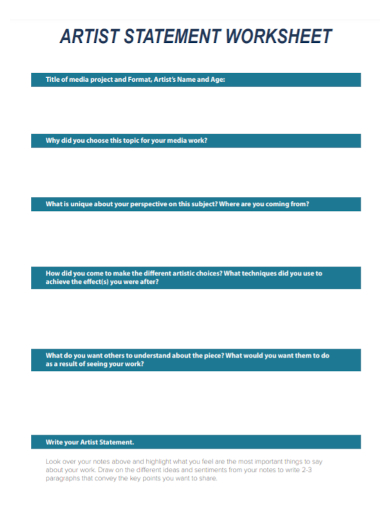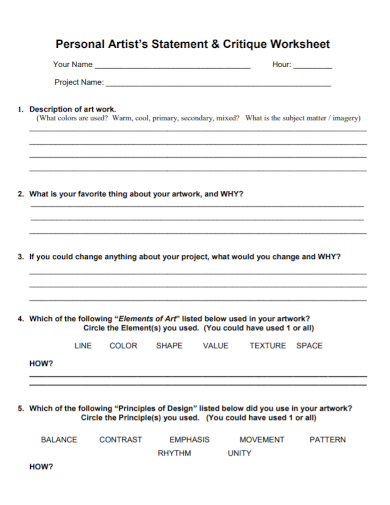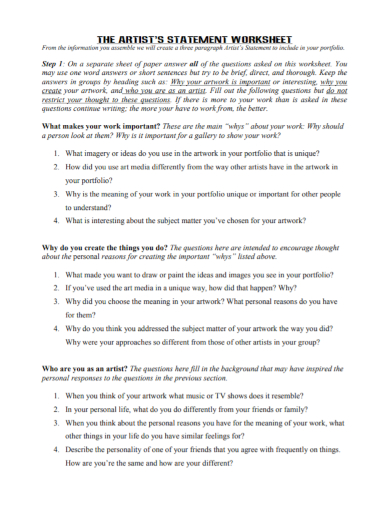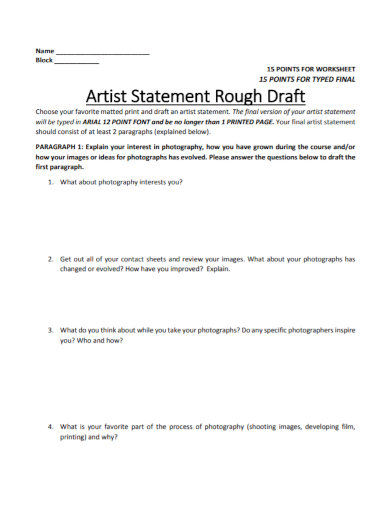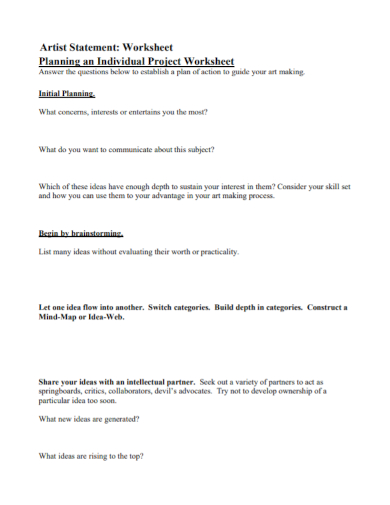Artists are one of the most creative people in the world. They can express different emotions, viewpoints, opinions, interests, and ideas in the art they create. Furthermore, their compelling works of art can influence people and inspire them a lot. But sometimes, art can convey different meanings to people and the purpose and inspiration of the artist’s work can be lost in translation when various people put in their own interpretation of it. That’s why an artist needs to have a statement to explain their work; the idea behind it and the methods they used to create it. If you’re an artist reading this and want to know how to make a statement to use for your work, you’re in the right place. Read the article to find out how to make an artist statement.
5+ Artist Statement Worksheet Samples
1. Artist Statement Worksheet
2. Personal Artist Statement Critique Worksheet
3. Sample Artist Statement Worksheet
4. Artist Statement Rough Worksheet
5. Artist Statement Project Worksheet
6. Artist Statement Application Worksheet
What Is an Artist’s Statement?
An artist statement is basically an artist’s written description of their work to help clarify the artist’s own ideas about their work to the viewers. Furthermore, it’s also a privilege for curators, gallery dealers, and the public to have access to the descriptions of your work since this will be useful when critics review your work, writers feature your work in magazines and newspapers, and video bloggers to showcase your work in their videos. an artist statement is also not limited to showing your art during public viewing, it is also important if you want to pursue teaching in fine arts, studying in arts graduate school, or proposing to sponsors to fund your work.
An artist statement has different types. The most common ones are:
- Full-page statement: This type of statement is most often used by artists because it generally describes their work, the methods they used, the history of their work, etc., and examples of their current work.
- Short statement: Similar to a full-page statement, although it only focuses on one specific work of the artist.
- Short project statement: A quick statement about the specific project the artist is presenting.
- Short biography: A short description of the artist’s career as an artist and their major accomplishments.
How to Write an Artist’s Statement
1. Know Your Viewers
To start writing your statement, find out who your audience is. Your writing style and the content of your statement will depend on your audience. Even if your statement talks about your work, you also have to make sure that you’re communicating with your audience. Make sure they get the message of your work through your statement.
2. Introduction
Start your statement with an introduction to your work. Make your introduction pop so readers would be interested in reading the rest of your statement. Your introduction should open with the work’s basic ideas in two or three sentences or a short paragraph.
3. Details of the Statement
Consider what your statement will say about you as an artist and your works. The second paragraph should go into detail about any issues or ideas are presented in the work. You can use the following points below to guide you on writing your statement:
- Why have you created the work? What are you trying to say in the work?
- What or who influences your work?
- How do your methods or techniques support the content of your work?
- What’s the best way someone has responded to your artwork?
- What questions are you asked most frequently about your work?
- What’s your artist’s story?
- Who is your art for?
- What do you expect from your audience and how they will react?
- How your current work relates to your previous work?
End your statement with a strong summary such as identifying the overall theme of your art in one to two short sentences.
4. Other Important Points to Keep in Mind
When writing the artist statement, refer to yourself in the first-person point of view. Make sure your statement is a clear, direct, honest, and concise reflection of yourself as an artist and your work. Organize your important points in your statement. Significant ideas must be at the end of each sentence to emphasize them.
FAQs
How many words is an artist’s statement?
An artist statement generally averages between 150-200 words or around two paragraphs. It is the best length for a statement for viewers to learn more about the artist and their work, but not too long that they can no longer follow the artist’s story and get distracted.
Is an artist statement necessary?
An artist statement is necessary for artists that are starting out or aren’t yet popular to the general audience, however, for big name artists, they don’t need to write an artist statement because other people, such as journalists, will write about their work for them.
What are the 7 different forms of art?
The seven forms of arts are painting, architecture, sculpture, literature, music, performing, and cinema.
Once you reviewed your statement and revised it to make sure it captures the description of the essence of your artistry and your work, it’s time to print them and present them. You can present them in a binder with your resume, list of artworks, and reviews or articles that feature your work, which you can use for a panel to screen your art or apply for a job, hang it on a wall to inform viewers of your artwork during a public viewing, include in the application package of the grant you’re applying for, or to anyone who would benefit the information. To help you get started on writing the statement, download our free sample templates provided above!
Related Posts
FREE 20+ Training Sheet Samples in PDF | MS Word
FREE 20+ Employee Sheet Samples in PDF | MS Word
FREE 10+ Employee Attendance Sheet Samples in PDF
FREE 12+ Balance Sheet Formats in MS Word | PDF | Excel
FREE 5+ Construction Bid Sheet Samples in PDF | MS Word | Excel
FREE 15+ Construction Timesheet Samples in PDF | MS Word
FREE 26+ Construction Sheet Samples in MS Word | Google Docs | Excel
FREE 20+ Continuation Sheet Samples in PDF | MS Word
FREE 25+ Program Sheet Samples in MS Word | Google Docs | Pages | PDF
FREE 33+ Student Sheet Samples in PDF | MS Word
FREE 32+ Planning Sheet Samples in PDF | MS Word
FREE 10+ OC Sheet Samples in PDF
FREE 10+ Beat Sheet Samples in PDF
FREE 3+ Paper Sign Up Sheet Samples in PDF
FREE 50+ Summary Sheet Samples in MS Word | Google Docs | Google Sheets | Excel | PDF

